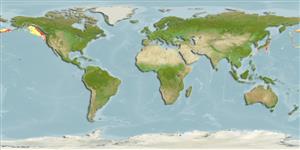Pycnogonida |
Pantopoda |
Nymphonidae
Environment: milieu / climate zone / গভীরতার পরিসীমা / distribution range
বাস্তুসংস্থান
; গভীরতার পরিসীমা 756 - 3940 m (সূত্র 2157). Temperate
Northern Pacific: USA.
Length at first maturity / আকৃতি / Weight / Age
পরিপক্কতা : Lm ? range ? - ? cm
Ocular tubercle well developed with large anterior pair of eyes, posterior pair either inconspicuous or lacking. With two of above males , anterior pair of eyes quite conspicuous but slightly pigmented, smaller posterior pair of eyes present but very inconspicuous, apparently unpigmented. Lateral processes well separated in quite slender species. Terminal palp segment shorter than penultimate segment. Oviger claw short, without teeth, no longer than distal denticulate spines of terminal segment. Spines with either two or three lateral lobes. Propodus shorter than slender tarsus with terminal claw little more than half length of propodus. Male cement gland apertures several inconspicuous ventral pores on femorae (Ref. 2157, p. 7).
Bathyal to abyssal (Ref. 19).
Life cycle and mating behavior
পরিপক্কতা | প্রজনন | ডিম ছাড়া | Eggs | ডিম্বধারন ক্ষমতা | Larvae
Members of the class Pycnogonida are gonochoric and sexually dimorphic. During copulation, male usually suspends itself beneath the female. Fertilization occurs as the eggs leave the female's ovigers. Males brood the egg masses until they hatch. Life cycle: Eggs hatch into protonymphon larva then to adults.
Child, C.A. 1994 Deep-sea Pycnogonida from the temperate west coast of the United States. Smithsonian Contributions to Zoology 556:1-23. (সূত্র 2157)
IUCN Red List Status
(সূত্র 130435: Version 2025-1)
CITES status (সূত্র 108899)
Not Evaluated
Not Evaluated
Threat to humans
Human uses
| FishSource |
হাতিয়ার
আরো তথ্য
ট্রফিক বাস্তুতন্ত্র Food items (preys)
পথ্য উপাদান
খাদ্য গ্রহণ
শিকারী প্রাণী সমূহ
Population dynamicsবৃদ্ধি
Max. ages / sizes
Length-weight rel.
Length-length rel.
Length-frequencies
Mass conversion
প্রাচুর্য
Life cycleপ্রজনন পরিপক্কতা ডিম্বধারন ক্ষমতা ডিম ছাড়া EggsEgg developmentLarvae Physiologyঅম্লজান ব্যবহার
Human RelatedStamps, coins, misc.
ইন্টারনেট সুত্র
Estimates based on models
Price category
Unknown.
